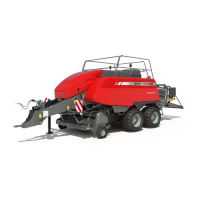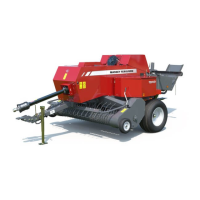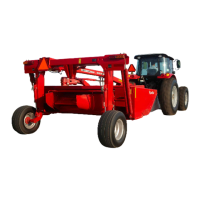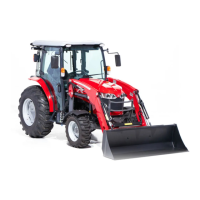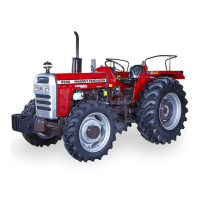1-17
MF 5650 ADVANCED
1. Safety Guidelines
1
14 - Fill the harvester always at the end of each
work day. This will avoid that, during the night,
the moisture inside the tank(s) condensate and
turn into water, contaminating the fuel, which
when reaching the pump and the nozzles
would cause irreparable damages.
15 - Before handling fuel, clean the area around
the filling cover. If the original cover is lost,
replace by another original one. Tight it firmly.
16 - The drums must be stored under a protective
shelter in other to prevent water from entering,
and they must have a light inclination for the
water to flow out from the upper border. The
fuel drums must not be stored for long periods.
17 - Drums stored without protective shelter must
have the plug firmly threaded to prevent water
from entering.
18 - Under no circumstance add other types of fuel
to diesel oil. This increases the risk of fire or
explosion. In closed containers, as a fuel tank,
this mixture is more explosive than pure
gasoline. Mixing diesel with alcohol is not
recommended, because it impairs the proper
lubrication of fuel injection system.
19 - Build the fuel reservoir away from pits, houses
or stables. Keep a clean space around the
reservoir so that, in case of fire, materials that
can help propagate fire are not reached.
20 - Do not smoke or install electric equipment that
produce sparks near the reservoir.
Keep the filling hose under control.
21 - Never remove the cover or refill with the engine
running or hot.
22 - Place visible warnings with the following
words:
WARNING!
FLAMMABLE - DO NOT SMOKE
IMPORTANT:
Observe the maintenance procedures to
keep the equipment in good conditions.
12.2 - Specifications
Limiting requirements for diesel oil:
NOTE:
Diesel oil is not classified as fuel # 1 (#
1-D) or # 2 (# 2-D).
Fuel grade # 1 is recommended for jobs
in which the temperature is below 32 °F.
Fuel grade # 2 is recommended for jobs
in which the temperature is 32 °F, or
above. See the chart for fuel
requirements.
44
44
4 To achieve the special operation conditions,
changes of requirements for individual
limitations can be agreed between the buyer,
the seller and the manufacturer.
44
44
4 For operation in hot weather, the pour point is
10 °F (5.6 °C) below the room temperature
where the tractor is going to operate, except
when facilities are provided to warm the fuel.
44
44
4 When the pour point specified is lower than 0
°F (-17.8 °C), the viscosity must be 1.8 cSt (32.0
SUS) and at least 90 % shall be pointed out.
44
44
4 In other countries, except the USA, other
sulphur limits can be applied.
44
44
4 Where the cetane number by method D 613 is
not available, method ASTM D 976 -
Calculated Cetane Index for Distilled Fuels 2 -
which can be used as an approximation. When
there is a discrepancy, Method D 613 is
preferred.
44
44
4 Engine that run at low atmospheric
temperatures, as well as at high altitudes, may
require fuels with high rates of cetane.
44
44
4 Fuels with low index of sulphur may require
an additional lubrication agent to protect the
injection pump. You must consult the fuel
supplier to assure the fuel purchased has the
suitable quantity of lubricant.

